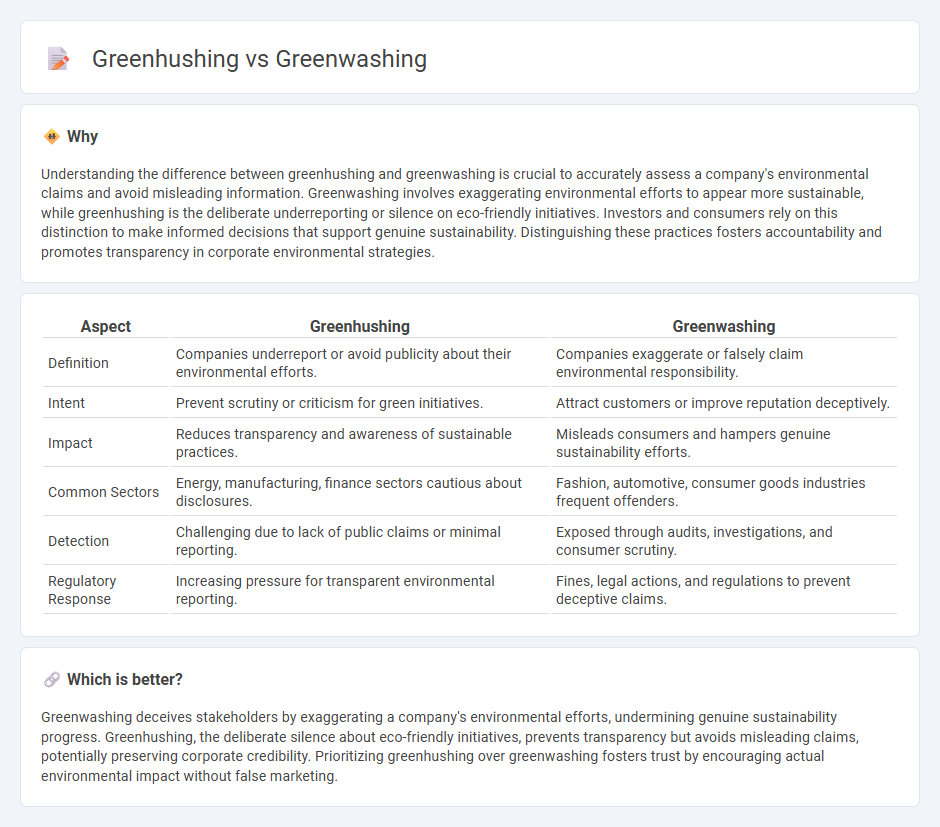
Greenhushing and greenwashing are two contrasting tactics used by companies to manage their environmental image. While greenwashing involves exaggerating or fabricating environmental efforts to attract eco-conscious consumers, greenhushing entails deliberately downplaying or hiding sustainability initiatives to avoid scrutiny or backlash. Explore these critical concepts to understand their impact on corporate transparency and consumer trust in the evolving green economy.
Why it is important
Understanding the difference between greenhushing and greenwashing is crucial to accurately assess a company's environmental claims and avoid misleading information. Greenwashing involves exaggerating environmental efforts to appear more sustainable, while greenhushing is the deliberate underreporting or silence on eco-friendly initiatives. Investors and consumers rely on this distinction to make informed decisions that support genuine sustainability. Distinguishing these practices fosters accountability and promotes transparency in corporate environmental strategies.
Comparison Table
| Aspect | Greenhushing | Greenwashing |
|---|---|---|
| Definition | Companies underreport or avoid publicity about their environmental efforts. | Companies exaggerate or falsely claim environmental responsibility. |
| Intent | Prevent scrutiny or criticism for green initiatives. | Attract customers or improve reputation deceptively. |
| Impact | Reduces transparency and awareness of sustainable practices. | Misleads consumers and hampers genuine sustainability efforts. |
| Common Sectors | Energy, manufacturing, finance sectors cautious about disclosures. | Fashion, automotive, consumer goods industries frequent offenders. |
| Detection | Challenging due to lack of public claims or minimal reporting. | Exposed through audits, investigations, and consumer scrutiny. |
| Regulatory Response | Increasing pressure for transparent environmental reporting. | Fines, legal actions, and regulations to prevent deceptive claims. |
Which is better?
Greenwashing deceives stakeholders by exaggerating a company's environmental efforts, undermining genuine sustainability progress. Greenhushing, the deliberate silence about eco-friendly initiatives, prevents transparency but avoids misleading claims, potentially preserving corporate credibility. Prioritizing greenhushing over greenwashing fosters trust by encouraging actual environmental impact without false marketing.
Connection
Greenhushing and greenwashing both distort corporate environmental communication, with greenhushing involving underreporting or silencing sustainability efforts, while greenwashing exaggerates or fabricates eco-friendly claims. These practices undermine transparent corporate accountability and mislead stakeholders about genuine environmental impact. Recognizing their connection is essential for enforcing accurate reporting standards and fostering sustainable business practices that contribute to the global economy.
Key Terms
Sustainability
Greenwashing involves companies misleading consumers by exaggerating their environmental efforts, while greenhushing refers to organizations deliberately downplaying or hiding their sustainability initiatives to avoid scrutiny. Both practices undermine genuine progress towards sustainability and distort public perception of environmental responsibility. Explore further to understand how transparency in sustainability reporting fosters trust and drives true environmental impact.
Corporate Social Responsibility (CSR)
Greenwashing involves companies exaggerating or falsifying their environmental efforts to enhance their Corporate Social Responsibility (CSR) image, misleading consumers and stakeholders about their sustainability practices. In contrast, greenhushing occurs when corporations deliberately underreport or conceal positive environmental actions to avoid scrutiny or accusations of insincerity within their CSR initiatives. Explore detailed insights on how these behaviors impact genuine sustainability and stakeholder trust in CSR.
Transparency
Greenwashing involves companies misleading consumers by exaggerating their environmental commitments, while greenhushing refers to businesses intentionally downplaying or hiding sustainability efforts to avoid scrutiny. Transparency in sustainability reporting is crucial to differentiate genuine eco-friendly initiatives from deceptive practices and silence surrounding positive impacts. Explore detailed strategies and case studies to understand how transparency combats both greenwashing and greenhushing effectively.
Source and External Links
What Is Greenwashing and How to Avoid It? - Earth.Org - Greenwashing occurs when a company spends more effort marketing itself as sustainable than actually reducing its environmental impact, misleading eco-conscious consumers.
Greenwashing Examples for 2024 & 2025 - The Sustainable Agency - Greenwashing involves deceptive tactics to make brands appear more sustainable than they truly are, such as changing packaging while maintaining unsustainable practices, or using eco-friendly labels on products that are not genuinely better for the environment.
Sins of Greenwashing - UL - The "Seven Sins of Greenwashing" framework helps identify misleading environmental claims, such as emphasizing a few green features (hidden trade-off), lack of evidence (no proof), and ambiguous language (vagueness), which all lead to consumer confusion about a product's true environmental impact.
 dowidth.com
dowidth.com